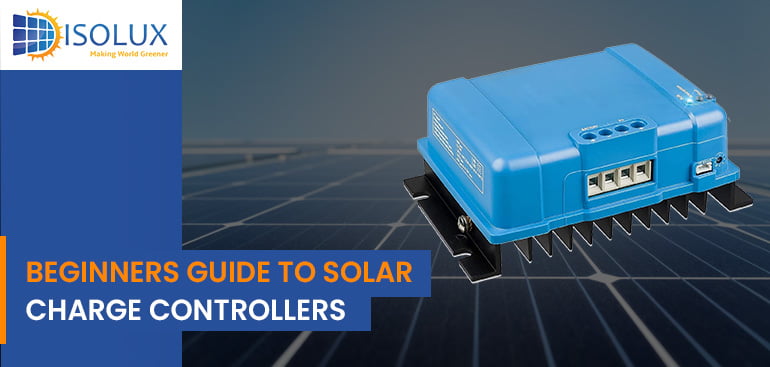A solar charge controller is a critical component of any solar power system. It regulates the flow of electricity from the solar panels to the battery, ensuring that the battery is not overcharged or damaged. A high-quality solar charge controllers can help to maximize the efficiency of your solar power system and protect your investment.
This guide will provide a comprehensive overview of solar charge controllers, including how they work, the different types available, and how to choose the right one for your needs.
How Solar Charge Controllers Work
A solar charge controller works by monitoring the voltage and current coming from the solar panels and controlling the amount of charge sent to the battery. When the battery is fully charged, the solar charge controller will stop the flow of electricity to the battery, protecting it from overcharging.
The solar charge controller also ensures that the battery does not discharge too much, which can cause damage. When the battery voltage drops too low, the solar charge controller will automatically turn on and start sending electricity to the battery again, maintaining the optimal charge level.
Types of Solar Charge Controllers
There are two main types of solar charge controllers: PWM (Pulse Width Modulation) and MPPT (Maximum Power Point Tracking).
1. Pulse Width Modulation Solar Controllers
Pulse Width Modulation (PWM) solar regulators are a type of solar charge controller commonly used in small-scale solar power systems. They work by regulating the flow of electricity from the solar panels to the battery, ensuring that the battery is not overcharged or damaged.
PWM solar regulators are a simple and affordable option, but they are not as efficient as Maximum Power Point Tracking (MPPT) regulators. However, for small-scale solar power systems, PWM regulators can still be an effective solution.
How PWM Solar Regulators Work
PWM solar regulators work by monitoring the voltage and current coming from the solar panels and controlling the amount of charge sent to the battery. When the battery is fully charged, the regulator will stop the flow of electricity to the battery, protecting it from overcharging.
The regulator also ensures that the battery does not discharge too much, which can cause damage. When the battery voltage drops too low, the regulator will automatically turn on and start sending electricity to the battery again, maintaining the optimal charge level.
Advantages of PWM Solar Controllers
Affordability: PWM solar regulators are generally less expensive than MPPT regulators, making them an attractive option for those on a tight budget.
Simplicity: PWM regulators are a simple and straightforward solution, making them easy to install and maintain.
Disadvantages of PWM Solar Regulators
Efficiency: PWM regulators are less efficient than MPPT regulators, meaning that they can waste some of the energy from the solar panels.
Limited compatibility: PWM regulators may not be compatible with all types of batteries, so it’s important to check compatibility before purchasing.
2. Maximum Power Point Tracking Solar Regulator
Maximum Power Point Tracking (MPPT) solar regulators are a type of solar charge controller commonly used in medium to large-scale solar power systems. They work by optimizing the flow of electricity from the solar panels to the battery, ensuring that the battery is charged efficiently and effectively.
MPPT solar regulators use advanced algorithms to track the maximum power point of the solar panels, allowing for maximum energy conversion from the panels to the battery. This results in higher efficiency compared to traditional Pulse Width Modulation (PWM) regulators.
How MPPT Solar Regulators Work
MPPT solar regulators work by monitoring the voltage and current coming from the solar panels and optimizing the flow of electricity to the battery. The regulator uses algorithms to track the maximum power point of the solar panels and adjust the flow of electricity to the battery accordingly. This allows for maximum energy conversion from the panels to the battery.
The regulator also ensures that the battery is not overcharged or damaged. When the battery is fully charged, the regulator will stop the flow of electricity to the battery, protecting it from overcharging. When the battery voltage drops too low, the regulator will automatically turn on and start sending electricity to the battery again, maintaining the optimal charge level.
Advantages of MPPT Solar Regulators
Efficiency: MPPT solar regulators are more efficient than PWM regulators, meaning that they can convert more energy from the solar panels to the battery.
Compatibility: MPPT regulators are compatible with a wide range of battery types, making them a versatile solution.
Advanced features: MPPT regulators often come with advanced features such as temperature compensation, which can improve the performance of the system.
Disadvantages of MPPT Solar Regulators
Cost: MPPT solar regulators are generally more expensive than PWM regulators, making them less accessible for those on a tight budget.
Complexity: MPPT regulators are more complex than PWM regulators, making them harder to install and maintain.
Choosing the Right Solar Charge Controller
When choosing a solar charge controller, there are several factors to consider, including the size of your solar power system, the type of battery you are using, and your budget.
Solar Panel Output
The first thing to consider is the output of your solar panels. This will determine the size of the solar charge controller you need. Make sure to choose a solar charge controller that can handle the maximum output of your solar panels.
Battery Type
The type of battery you are using will also determine the type of solar charge controller you need. Different batteries have different voltage and current requirements, so make sure to choose a solar charge controller that is compatible with your battery.
Budget
Finally, consider your budget. MPPT solar charge controllers are more expensive than PWM controllers, but they are also more efficient. If you have the budget for an MPPT controller, it is recommended to choose one for maximum efficiency. However, if you are working with a tight budget, a PWM controller will still effectively regulate the flow of electricity to your battery.
Conclusion
In conclusion, a solar charge controller is a critical component of any solar power system, ensuring the protection of your battery and maximizing the efficiency of your solar panel system. By considering the size of your solar panels, the type of battery you are using, and your budget, you can choose the right solar charge controller for your needs.
Switch to solar today!
Get a Free Quote from Isolux Solar – a solar installer in Sydney to reduce your electricity bill.
Read Next Blog:




